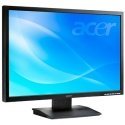Difference Between TN and PVA

Twisted Pneumatic (also known as TN) is a type of Thin Film Transistor Liquid Crystal Display (or TFT LCD) screen – found in flat screen and plasma televisions. It is the most common LCD screen used by consumers, as a result of its sophisticated pixel response time, which is fast enough to avoid the ‘shadow-trail’ or ‘ghosting’ effect (an effect that leaves a ‘ghost image’ after the television is turned off, that was found in earlier LCD televisions).
Patterned vertical alignment (also known as PVA) is a variant of the multi-domain vertical alignment (or MVA) technology found in some LCD screens. The PVA offers a higher contrast ratio than the MVA LCD screen (offered by Samsung’s and Sony’s S-LCD television series). The PVA was developed independent of the MVA, resulting in a contrast ratio as pristine as 3000:1.
Both the TN and PVA offer a less expensive alternative to many of the LCD offerings. However, this is where their similarities end. The TN does cut down on the ghosting effect; however, the technology is limited by its lackluster viewing angles, especially when it comes to vertical viewing. When viewed askew (at an off-perpendicular angle), the colors tend to shift. When viewed vertically, the shift is so strong that the colors invert beyond certain angles. TN panels are also limited in their color representation – only showcasing colors using 6 bits per color instead of the more efficient 8 bits. As a result, TN screens are incapable of displaying the 16.7 million color (equating to the 24 bit true color) shades available on all graphic cards.
PVA screens were designed to take care of the off angle color warping problem found in TN screens. Super PVA (S-PVA) screens will use at least an 8 bit per color component. S-PVAs also avoid using color simulation methods. These screens have made it easier to view images on a screen, eliminating off-angle glowing (consistent with solid blacks), and off-angle gamma shifting. Both PVA and S-PVA screens offer the best black depth in the LCD family, and offer incredible viewing angles.
Summary:
1. TN is the most common LCD screen used by consumers; PVA is a permutation of the MVA screen, developed independently.
2. TN has limited viewing angles; PVA screens have a wide array of viewing angles that cut down on gamma shifting and off-angle glowing.
3. TN screens only use 6 bits per color; PVA screens use at least 8 bits per color.
- Difference Between VC++ and C++ - April 20, 2010
- Difference Between Aluminum and Carbon Arrows - April 15, 2010
- Difference Between SFTP and SCP - April 15, 2010
